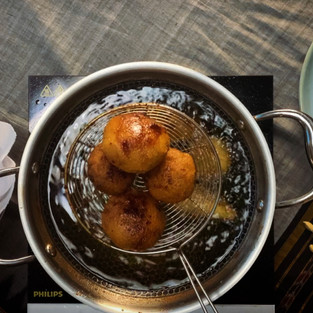Sooji Kakara Pitha
- Garlik Shots

- Nov 16, 2020
- 3 min read
Crunchy outside, soft & juicy on the inside, this traditional dessert dish from Odisha steals every odia’s heart.
Pithas are a dear delicacy to all Odias. There are unique pitha meant to be made specifically for each festival.
Pithas are types of fritter, pancake or dumpling from the eastern regions of India. They can be of s all dumpling-sized to crepe- sized. Pithas can be sweet or savoury and usually made from a dough or batter, which is then steamed, fried or griddled. Very few varieties are oven-baked or boiled, and most are unleavened and cooked on a stovetop (or equivalent). Some versions may have a filling, garnish, or sauce. Few may be set or shaped after cooking. They are typically eaten as treats during special/ festive occasions (similar to mithai).
Though we have many varieties of Pithas, Sooji Kakara Pitha is especially famous. Deep-fried lightly sweetened semolina balls with a freshly grated coconut & Jaggery filling, Kakara adds a variety of textures to the mouth. The outer layer of Semolina gives it the greatest crunch & golden brown colour to the pitha. It is indeed a treat to both the eyes & the palette.
As a child, I always looked forward to Diwali as this was the day my mother would make Sooji kakara pitha without fail. New clothes, crackers, bunking school & our most favourite pitha. What else does a child need to be happy. Ok. Enough talking, let's start making.

Prep time | 5 mins
Cooking time | 1.30 hrs
Portions | 4-5
Difficulty level | Intermediate-Advanced
Ingredients (for the outer layer)
Fine Sooji/ Rava/ Semolina, 1 Cup
Sugar, 2 tbsp
Salt, 2 pinches
Cardamom powder, ½ tsp
Ghee, ½ tsp
Water, 1 Cup
For Stuffing
Freshly Grated Coconut, 1 & ¼th Cup
Jaggery, ½ cup
Salt, 2 pinches
Cardamom Powder, 1, crushed
Cashews & Almonds, 1/4th cup, broken
Dried bay leaf, 1 small, broken into pieces
Other Ingredients
Oil for Deep Frying
Water to wet palms
Making the Stuffing
In a heavy-bottomed skillet/ kadhai, over medium flame, add the jaggery. Wait for it to melt & bubble up. Once it does, cook for around 2 mins. Add the grated coconut and cook for 2 mins. Add salt, crushed cardamom, dry fruits & bay leaf. Cook for 2 more mins. Turn off the heat & let it rest.
Dough for the outer layer
Add 2 cup of water in a kadhai. Keep it on a high flame until it starts to boil. Add salt, sugar & cardamom powder. Reduce the flame and slowly pour the Sooji into the water while stirring all the time to reduce lumps. Keep stirring till it starts to come together & forms a dough.
Use a spatula to fold & press the dough. Turn off the flame, add the ghee to the dough. Keep folding and pressing the dough until it becomes soft & smooth. Our dough is ready.
Making the Suji Kakara Pitha
Set aside a bowl of water to dip your palm while working with the dough. It helps to stop the dough from sticking to your hand. Divide the dough for the outer layer and the stuffing into ten equal portions.
Take one portion of the dough into your palm and kneed it for a few seconds. Roll the dough into a ball.
Use the thumb finger at the centre of the dough & press around the corners to make it into a pocket. Refer to the video or the images below for better understanding.
Place one portion of the stuffing in the middle.

Slowly fold the edges inward while rotating it in your palm.
Make sure the ball is sealed from all side. Ensure there are no cracks are present in the outer layer. five it a shape of dish.

Repeat the process to shape all Kakara Pithas. You can explore and make varieties of shapes as shown in the video.
In a kadhai, over medium flame, heat the oil. To test the temperature of the oil, drop a pinch of the rava dough. It should sizzle immediately. When the oil is hot enough, gently slide pithas into it and let them fry for about 2-3 minutes. Do not flip them over immediately. After 2 minutes, gently flip the pithas. Continue to fry while flipping the pitha at regular intervals until they are golden brown. I like them to be extra crunchy, so I continue frying until they turn dark golden brown.
Remove from the oil and drain all oil from the pitha. Repeat the process to fry all pithas.
Enjoy them warm.



















































Comments